You love your feathered friend, and you want to make sure they are well-fed and healthy. But how often should you be feeding them, and how much should you be giving them? It can be confusing and overwhelming to figure out the best feeding schedule and portions for your bird, but with a little bit of knowledge and effort, you can ensure that your bird is getting the nutrition they need to thrive.
On one hand, you don’t want to overfeed your bird and risk obesity and health problems. On the other hand, you don’t want to underfeed them and leave them feeling hungry and malnourished. So, how do you strike the right balance?
In this article, we’ll guide you through the process of:
– Understanding your bird’s nutritional needs
– Determining a feeding schedule
– Measuring your bird’s food
– Choosing the right foods
– Monitoring your bird’s health
By the end of this article, you’ll have the tools and knowledge you need to ensure that your bird is well-fed and happy.
Key Takeaways
– Feeding schedule should take into account bird’s dietary needs and preferences, generally twice a day is recommended.
– Portion control is important to avoid overfeeding or underfeeding, measuring tools such as cups, spoons, and scales should be used.
– Smaller birds may require more frequent feedings while larger birds may only need to be fed once or twice a day.
– Adjust portions as needed to maintain a healthy weight, and monitor bird’s weight regularly to catch any changes early on.
Understand Your Bird’s Nutritional Needs
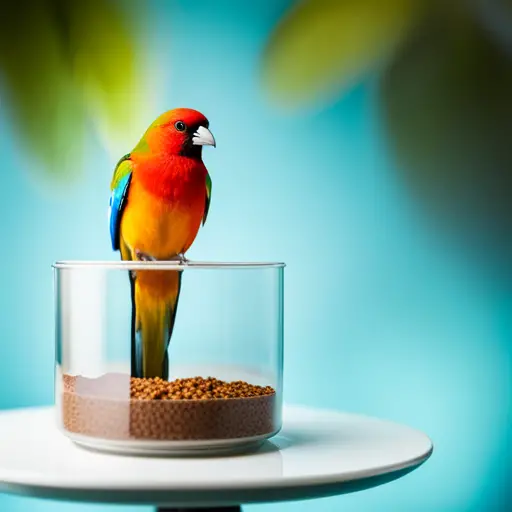
You’ll need to familiarize yourself with your bird’s nutritional needs in order to determine how often and how much to feed them. There are different types of bird food available in the market, such as pellets, seeds, fruits, and vegetables.
Pellets are a great source of balanced nutrition, and they provide all the necessary vitamins and minerals to keep your bird healthy. Seeds, on the other hand, are high in fat and should be given in moderation. Fruits and vegetables are also an important part of your bird’s diet as they provide essential vitamins and minerals.
In addition to feeding your bird the right type of food, it’s also important to provide them with fresh water at all times. Birds need water to stay hydrated and to aid in digestion. Make sure to change their water daily to prevent the growth of bacteria.
With a good understanding of your bird’s nutritional needs, you can determine a feeding schedule that works best for them.
Determine a Feeding Schedule
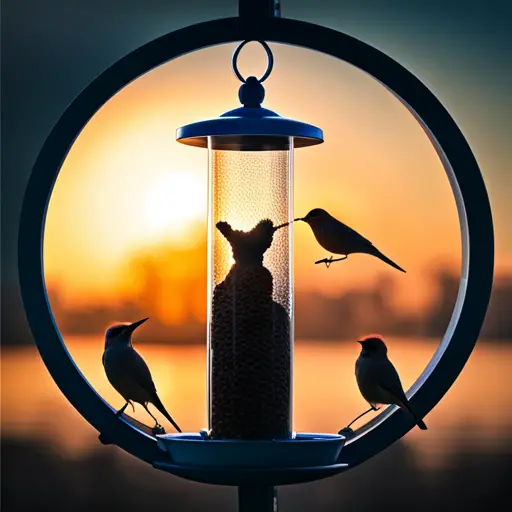
Feeding your feathered friend requires a carefully crafted schedule that takes into account their unique dietary needs and preferences. Determining how often to feed your bird and how much to give them can be a bit tricky, but with some basic guidelines, you can create a feeding schedule that works for both you and your bird.
When it comes to feeding frequency, it’s generally recommended to offer your bird food twice a day, once in the morning and once in the evening. This mimics their natural feeding patterns in the wild, where they would forage for food in the morning and evening and rest during the day. However, some birds may prefer to have smaller, more frequent meals throughout the day. It’s important to pay attention to your bird’s behavior and adjust their feeding schedule accordingly. Additionally, portion control is just as important as feeding frequency. Overfeeding can lead to obesity and health problems, while underfeeding can result in malnutrition and other health issues. The table below provides a general guideline for how much to feed your bird based on their size.
| Bird Size | Daily Food Portion |
|---|---|
| ———– | ——————– |
| Small | 1-2 tablespoons |
| Medium | 1/4 – 1/2 cup |
| Large | 1/2 – 1 cup |
As you develop a feeding schedule for your bird, remember to measure their food to ensure they are receiving the appropriate portion size. In the next section, we will discuss how to measure your bird’s food to ensure they are getting the right amount of nutrients.
Measure Your Bird’s Food
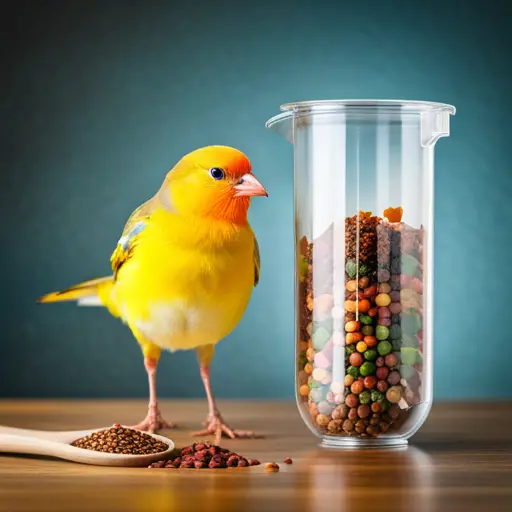
When measuring your bird’s food, it’s important to use measuring tools to make sure you’re giving them the correct portion size. Don’t rely on eye-balling the amount, as this can lead to overfeeding or underfeeding.
Adjust the portions as needed based on your bird’s activity level and overall health.
Use Measuring Tools
By using measuring tools, you can ensure that your feathered friend receives the perfect amount of food, just like a chef measuring out ingredients for a delicious meal. Measuring accuracy is essential for feeding consistency, as birds need a specific amount of food to maintain their health and energy levels.
Measuring cups and spoons are readily available and can be used to measure out food portions accurately. Using a scale is also an excellent way to ensure that your bird is getting the right amount of food. A digital kitchen scale can accurately measure the weight of the food, and you can adjust the portions accordingly.
By using measuring tools, you can avoid over or underfeeding your bird, which can lead to health issues. Don’t rely on eye-balling your bird’s food portions, as it can be challenging to judge the correct amount. Instead, use measuring tools to ensure that your feathered friend is getting the right amount of food.
Remember, feeding your bird the right amount of food is crucial for their health and well-being. By using measuring tools, you can be confident that your feathered friend is getting the perfect amount of food. Now, let’s move on to the next section, where we’ll discuss why eye-balling your bird’s food portions isn’t a reliable method.
Don’t Rely on Eye-balling
Using your eyes to estimate your bird’s food portions is not a reliable method, as it can lead to over or underfeeding. To ensure measuring accuracy, it is best to use a measuring tool such as a scale or measuring cups. This way, you can be sure that your bird is receiving the proper amount of food for their specific needs.
Feeding frequency is also an important factor to consider when determining how much to feed your bird. Smaller birds, such as finches or canaries, may require more frequent feedings throughout the day, while larger birds, such as parrots or macaws, may only need to be fed once or twice a day. By establishing a consistent feeding schedule and using measuring tools, you can ensure that your bird is receiving the appropriate amount of food. Remember to always adjust portions as needed and consult with a veterinarian if you have any concerns about your bird’s diet.
| Bird Type | Food Portion |
|---|---|
| ———– | ————– |
| Finches | 1-2 tsp |
| Canaries | 1-2 tbsp |
| Parakeets | 1-2 tbsp |
| Cockatiels | 1/4-1/2 cup |
| Parrots | 1/2-1 cup |
Adjust portions as needed to ensure your bird maintains a healthy weight and consult with your veterinarian if you have any concerns. Next, let’s discuss the importance of providing a variety of foods in your bird’s diet.
Adjust Portions as Needed
Don’t rely on eye-balling your bird’s food intake, as it can lead to overfeeding or underfeeding. Instead, use measuring tools to ensure that your feathered friend is getting the right amount of food each time.
But what happens when your bird’s weight starts to fluctuate? Portion control and weight management are crucial when it comes to feeding your bird. It’s important to adjust their food portions as needed to maintain a healthy weight.
Here are some tips to help you out:
1. Monitor their weight regularly to catch any changes early on.
2. Consult with your vet to determine the appropriate amount of food for your bird’s species and size.
3. Consider a food scale to accurately measure each meal.
4. Adjust their food portions if you notice any significant weight changes.
By following these guidelines, you can ensure that your bird is getting the right amount of food and maintaining a healthy weight. But now that you know how often and how much to feed your bird, it’s time to talk about what types of food to choose.
Choose the Right Foods
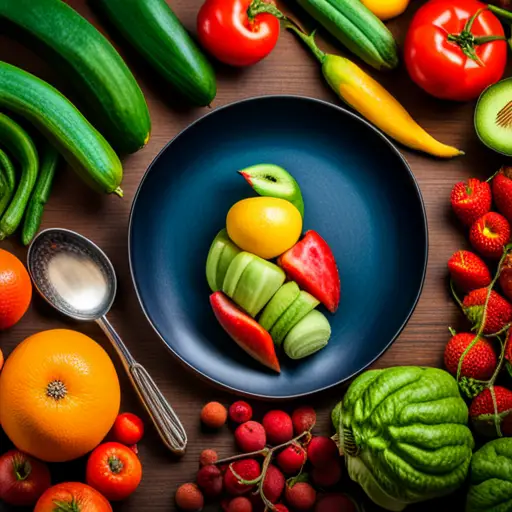
When it comes to choosing the right foods for your bird, it’s important to provide a balanced diet that meets their nutritional needs.
Offer a variety of foods to keep them interested and engaged, and avoid foods that can be harmful to birds.
By taking these steps, you can ensure that your feathered friend stays healthy and happy.
Provide a Balanced Diet
Adequate avian nutrition is essential to ensure a bird’s well-being, and providing a balanced diet is the best way to keep your feathered friend fit and flourishing.
Balancing nutrients is crucial because birds have different dietary requirements and restrictions depending on their species, age, and health condition.
A balanced diet should consist of foods that provide carbohydrates, protein, fat, vitamins, minerals, and water in the right proportions. For example, seeds are high in fat and protein, which are essential for energy and muscle development, but they lack essential vitamins and minerals. Therefore, you should supplement your bird’s diet with fresh fruits, vegetables, and fortified pellets to meet its nutritional needs.
Dietary restrictions are also important to consider when providing a balanced diet for your bird. Some birds may have allergies or sensitivities to certain foods, while others may require a specific diet due to medical conditions or breeding requirements. Therefore, it’s essential to consult with a veterinarian or an avian nutritionist to develop a personalized diet plan for your feathered friend.
By providing a balanced and customized diet, you can help your bird maintain optimal health and prevent nutritional deficiencies. So, offer variety and keep reading to learn more about how often you should feed your bird and how much.
Offer Variety
Now that you’ve learned about the importance of providing a balanced diet for your bird, it’s time to explore the benefits of offering variety. Birds, like humans, need a diverse range of nutrients to thrive. By incorporating different types of food into your bird’s diet, you can ensure that they receive the proper nutrients and vitamins they need to maintain optimal health.
To achieve this, try implementing a food rotation schedule. This means switching up your bird’s diet every few days to ensure they receive a variety of nutrients. Some excellent options include offering different types of fruits, vegetables, and grains. Additionally, you may want to consider incorporating nutritional supplements into your bird’s diet to further enhance their health and wellbeing. Some popular supplements include omega-3 fatty acids, probiotics, and calcium.
By providing a diverse range of foods and supplements, you can help your bird live a long, healthy life. It’s crucial to avoid feeding your bird foods that are harmful to their health. In the next section, we’ll discuss some of the foods you should stay away from to ensure your bird’s wellbeing.
Avoid Foods That Are Harmful to Birds
To safeguard your bird’s health, it’s essential to steer clear of foods that could be harmful to them. There are many bird safe foods that you can offer to your feathered friend, such as fresh fruits and vegetables, whole grains, and lean proteins. However, there are also many toxic foods that you should avoid feeding your bird, as they can cause serious health problems or even be fatal.
Here is a table to help you identify some common toxic foods that you should avoid feeding your bird:
| Toxic Foods | Safe Alternatives |
|---|---|
| ————- | ——————- |
| Avocado | Apples, bananas, berries, mango |
| Chocolate | Carob |
| Caffeine | Herbal tea |
| Alcohol | Water |
| Salt | Small amounts of natural mineral salt |
By being mindful of what you’re feeding your bird, you can help ensure their health and happiness. In the next section, we’ll discuss how to monitor your bird’s health to catch any potential issues early on.
Monitor Your Bird’s Health
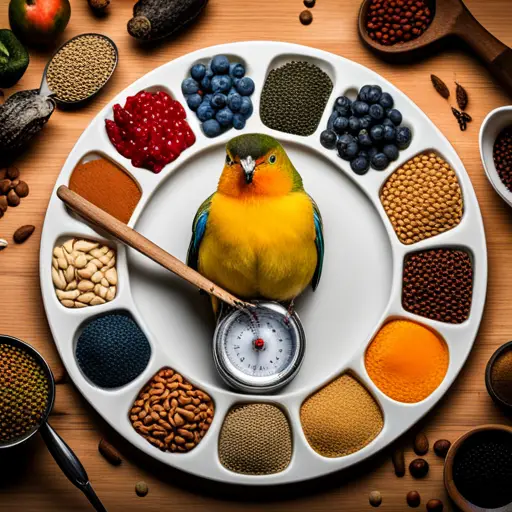
Keeping an eye on your bird’s health is crucial – it’s important to notice any changes in behavior or appetite. Here are a few tips to help you monitor your bird’s well-being:
1. Signs of hunger: If your bird appears restless or agitated, it may be a sign that it’s hungry. Birds can become irritable and aggressive when they’re hungry, so it’s important to make sure they’re getting enough food at regular intervals.
2. Avoid overfeeding: Birds can easily become overweight if they’re given too much food or treats. An overweight bird can suffer from a range of health problems, including heart disease, respiratory problems, and joint pain. Make sure you’re giving your bird the right amount of food based on its size and activity level.
3. Watch for changes in appetite: If your bird suddenly loses its appetite, it could be a sign of an underlying health issue. Similarly, if your bird starts eating more than usual, it may be a sign of a metabolic disorder or other health problem. If you notice any significant changes in your bird’s eating habits, it’s important to seek veterinary advice.
4. Regular check-ups: Just like humans, birds benefit from regular check-ups with a veterinarian. A vet can help you monitor your bird’s health, identify any potential issues before they become serious, and recommend preventative measures to keep your bird healthy and happy.
Conclusion
Congratulations! You’re now a bird feeding expert! You’ve learned all about your bird’s nutritional needs, how often to feed them, how much to give them, and even how to choose the right foods.
With all this knowledge, your bird will be the healthiest and happiest bird around! But let’s be real, you’re not just a bird feeding expert now, you’re practically a superhero!
You have the power to make your bird’s life better with every meal. So go ahead, feel proud of yourself, and give your feathered friend a big high five (or a pat on the beak) for being an awesome bird parent!
